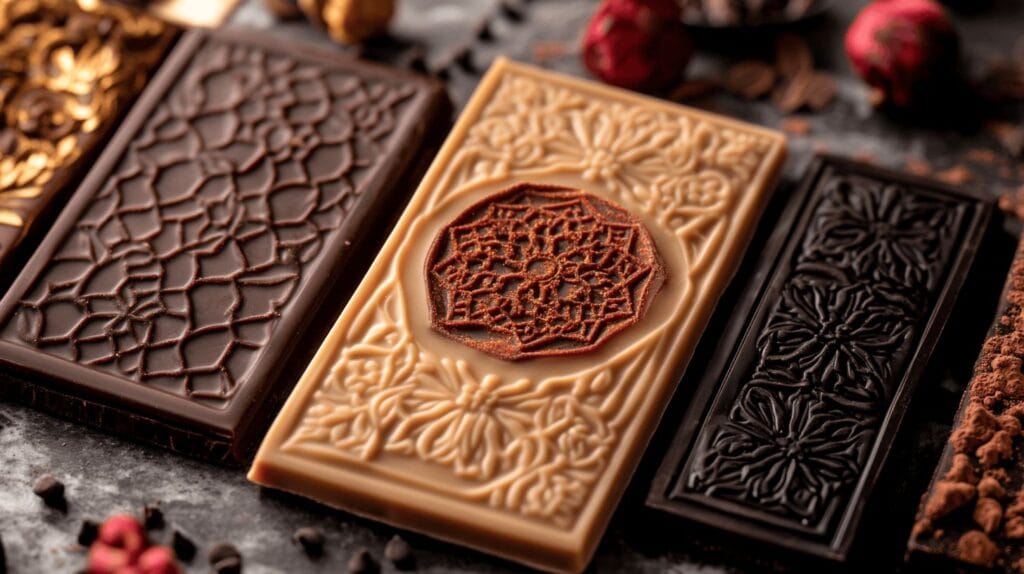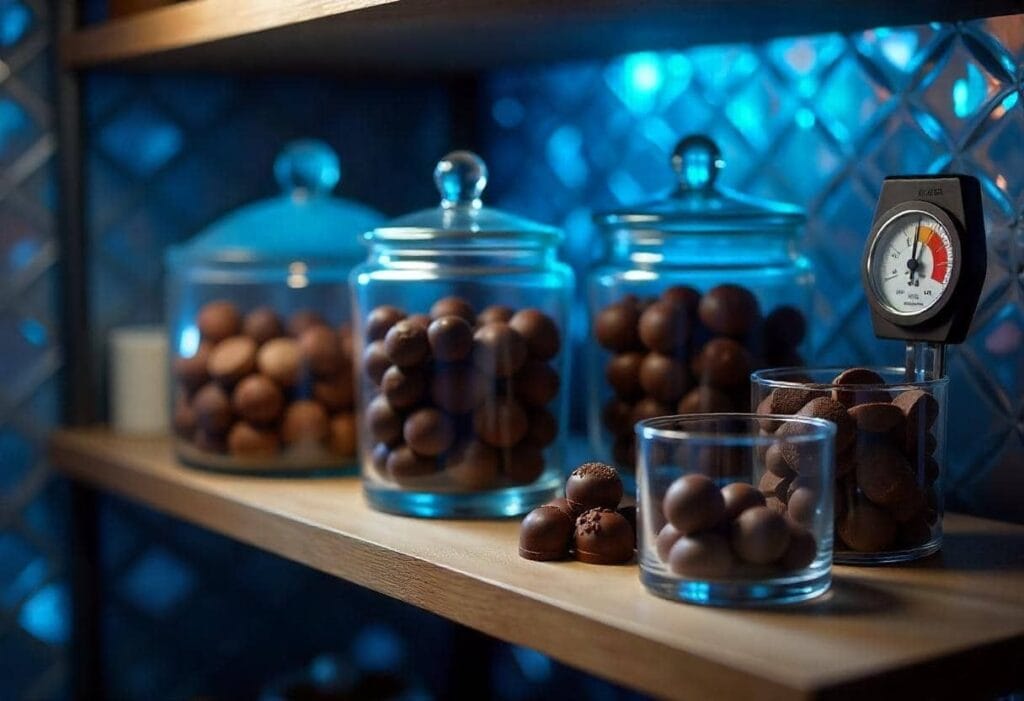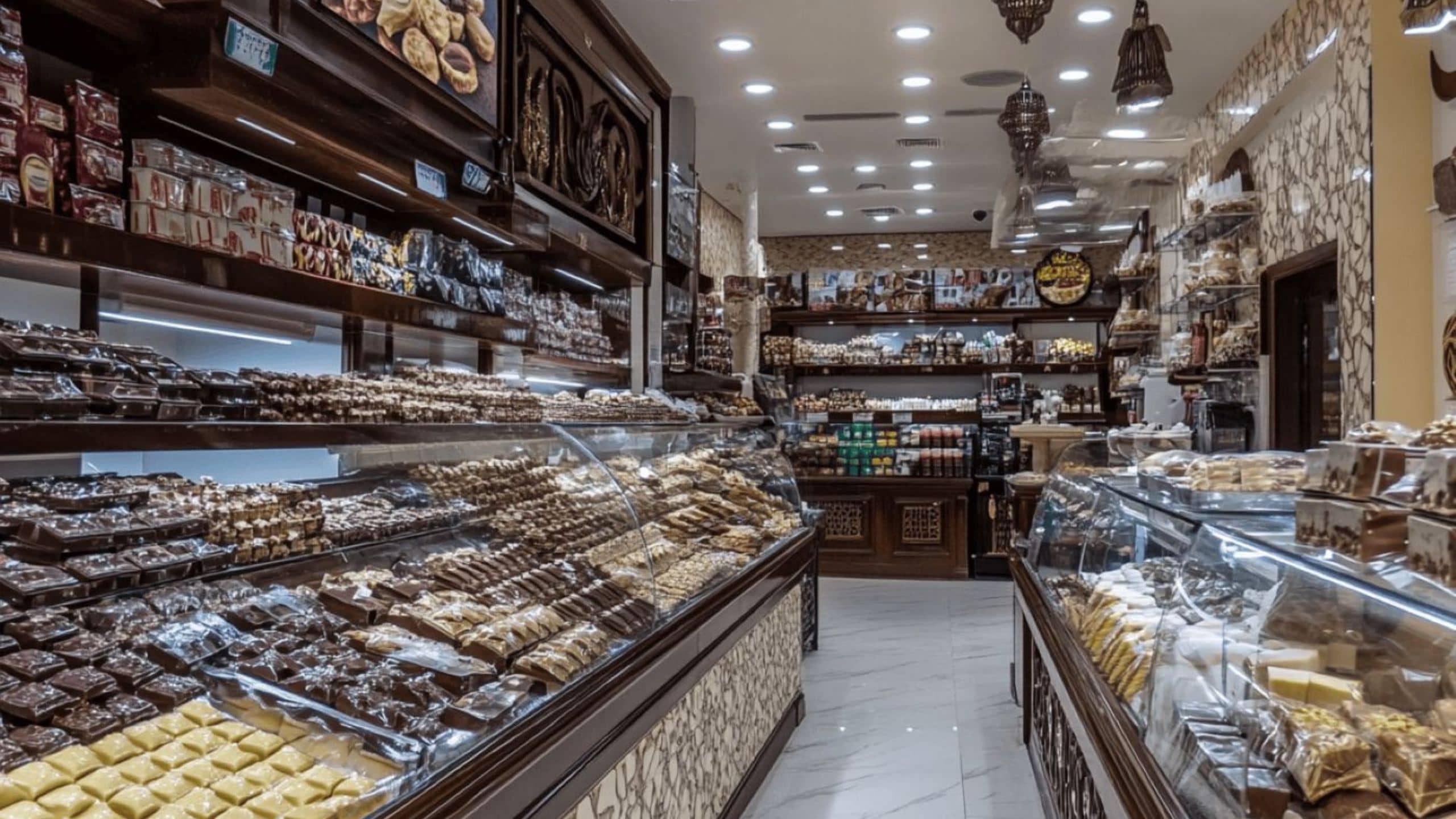Table of Contents
Introduction: Understanding Dubai Chocolate and Its Storage Needs
Does Dubai chocolate need to be refrigerated? Dubai is known for its luxury and high-end products, and chocolate is no exception. The region offers a variety of premium chocolates that attract both locals and tourists. However, Dubai’s hot and humid climate poses unique challenges for chocolate storage. High temperatures can cause chocolate to melt, while moisture in the air can lead to a dull appearance and grainy texture. To ensure chocolate stays fresh and maintains its quality, proper storage methods are essential. By understanding these needs, businesses and consumers can protect their investment and enjoy chocolate at its best.
What Makes Dubai Chocolate Unique?

Ingredients and Composition
Dubai chocolate stands out because of its carefully chosen ingredients. Chocolatiers in the region often blend premium cocoa beans with local flavors like saffron, cardamom, and dates. This fusion creates a distinctive taste profile that sets Dubai chocolate apart from others. Additionally, the use of high-quality milk, often sourced locally, adds a rich creaminess to the chocolate. Many varieties also feature unique fillings such as pistachios, almonds, or rose-flavored centers, catering to both traditional and modern palates.
Popular Brands and Variants
Dubai is home to several renowned chocolate brands that have gained popularity worldwide. Brands like Mirzam focus on artisan craftsmanship, offering bean-to-bar chocolate with a focus on storytelling through flavor. Others, like Al Nassma, specialize in camel milk chocolate, an exclusive and exotic treat that attracts tourists and locals alike. These brands provide a wide array of options, from dark and milk chocolates to more innovative variants like spiced truffles and gold-infused pralines, ensuring there’s something for everyone.
High-Quality Production Standards
The chocolate industry in Dubai adheres to strict quality standards to meet both local and international expectations. Advanced technology and meticulous processes are used to ensure consistency and excellence. Factories often maintain sterile environments and follow rigorous testing at each production stage. Moreover, sustainability plays a key role, with many brands sourcing ethical ingredients and employing eco-friendly packaging. This commitment to quality and sustainability enhances the reputation of Dubai chocolate on the global stage.
Factors Affecting Chocolate Storage
Temperature Sensitivity of Chocolate

Chocolate is highly sensitive to temperature changes, which can impact its texture and taste. Ideally, chocolate should be stored at a temperature between 15°C and 20°C to prevent melting or discoloration. If stored in warmer conditions, the cocoa butter can rise to the surface, creating a white film known as bloom. This doesn’t harm the chocolate but affects its appearance and texture. Extreme cold can also cause the chocolate to lose its smoothness, leading to a brittle texture.
The Role of Humidity
Humidity plays a critical role in maintaining chocolate quality. High humidity can cause condensation on the surface of the chocolate, leading to sugar bloom, which appears as a rough, powdery layer. This not only impacts the appearance but also alters the taste and texture. To avoid such issues, chocolate should be kept in a dry environment with humidity levels below 50%. Properly sealed packaging can further protect chocolate from moisture and air exposure.
Shelf Life Considerations
Chocolate has a varied shelf life depending on its type and composition. Dark chocolate tends to last longer due to its lower milk and moisture content, often remaining fresh for up to two years when stored correctly. Milk and white chocolates have shorter shelf lives, typically lasting between six months to a year. To maximize shelf life, chocolate should be stored in airtight containers away from strong odors, as it easily absorbs surrounding scents, which can alter its flavor.
Should You Refrigerate Chocolate?
Ideal Storage Conditions
Chocolate is best stored in a cool, dry place with consistent temperatures between 15°C and 20°C. Direct sunlight or heat sources should be avoided as they can cause the chocolate to melt or develop bloom, which affects both texture and appearance. A dark pantry or cupboard away from windows is an ideal spot. Properly sealing chocolate in an airtight container can also help protect it from environmental factors and preserve its original flavor.
Risks of Refrigeration
Refrigerating chocolate might seem like a safe option, but it carries certain risks. The cold environment can cause condensation to form on the chocolate when taken out, leading to sugar bloom, which makes the surface rough and unappealing. Refrigeration can also alter the texture, making it less creamy and smooth. Moreover, chocolate tends to absorb odors from other foods in the fridge, which can compromise its flavor.
Alternative Storage Solutions
If your environment is too warm for standard storage, there are better options than refrigeration. Placing the chocolate in a sealed, airtight bag before refrigerating can reduce the risk of odor absorption and moisture exposure. Before consuming, allow the chocolate to return to room temperature slowly while still sealed to prevent condensation. Another effective solution is using a temperature-controlled wine cooler, which maintains a steady, optimal climate for preserving chocolate without the drawbacks of a refrigerator.
How Dubai’s Climate Influences Chocolate Storage
Heat and Humidity in Dubai
Dubai’s intense heat and high humidity pose significant challenges for storing chocolate. Temperatures often exceed 40°C, causing chocolate to melt quickly if not properly stored. The high humidity adds another layer of difficulty, as it can lead to condensation when the chocolate moves from a cool to a warm environment. This moisture affects the texture and appearance of chocolate, creating a white, powdery layer called sugar bloom. To prevent these issues, storage must involve strict temperature and humidity control, often using specialized cooling systems to maintain an ideal environment of 16–18°C with low humidity.
Packaging Innovations for Local Storage
To combat the harsh climate, packaging innovations play a crucial role in keeping chocolate fresh and appealing. Many companies now use insulated and heat-resistant materials to shield chocolate from extreme temperatures. Vacuum-sealed packaging prevents air and moisture from entering, reducing the risk of condensation and spoilage. Some brands incorporate cooling gels or temperature-indicating labels that alert consumers if the chocolate has been exposed to unsafe conditions. These advancements ensure that chocolate remains in optimal condition, even in Dubai’s demanding climate.
Best Practices for Storing Dubai Chocolate
Finding the Right Spot in Your Home
Storing chocolate properly starts with finding the best spot in your home. Avoid areas near windows, ovens, or other heat sources that can raise the temperature. Bathrooms or laundry rooms are also unsuitable due to higher humidity levels. A cupboard away from direct sunlight and in a part of the house where the temperature remains stable is ideal. Keeping chocolate in such a location ensures it stays fresh and maintains its original texture and flavor.
Using Cool, Dry, and Dark Places
Chocolate thrives in cool, dry, and dark environments. Excessive heat can cause it to melt, while high humidity leads to sugar bloom. Direct light, even artificial, can affect its flavor and texture over time. Aim to store chocolate in a space where the temperature stays between 16°C and 18°C, with minimal exposure to moisture or light. This balance helps preserve the chocolate’s appearance, aroma, and taste.
Importance of Airtight Containers
Using airtight containers is a simple but effective way to protect chocolate from environmental factors. These containers block out humidity and prevent the chocolate from absorbing odors from other foods. They also guard against pests that might be attracted to chocolate’s sweet aroma. By sealing the chocolate in a high-quality container, you create a controlled environment that enhances its shelf life and ensures every bite remains delightful.
Myths About Refrigerating Chocolate
Common Misconceptions About Chocolate Storage
Many believe refrigerating chocolate is the best way to keep it fresh, especially in warm climates. While this seems logical, it can actually harm the quality of the chocolate. People often assume refrigeration preserves the flavor and texture, but cold environments can cause condensation. This moisture interferes with the cocoa butter, leading to an unpleasant appearance and altering the taste. Another common myth is that all chocolates should be refrigerated, but in reality, high-quality chocolates are better stored in a cool, dry place away from direct sunlight. This approach helps retain their intended texture and flavor.
The Science Behind Blooming in Chocolate
When chocolate is refrigerated, it can develop a whitish coating called “bloom.” This occurs when the cocoa butter separates and rises to the surface. Two main types of bloom can affect chocolate: fat bloom and sugar bloom. Fat bloom happens due to temperature fluctuations, causing the cocoa butter to melt and re-solidify unevenly. Sugar bloom, on the other hand, results from condensation. When refrigerated chocolate is exposed to warmer air, moisture dissolves the sugar on the surface, leaving a grainy residue after evaporation. These changes don’t make the chocolate unsafe to eat, but they compromise its visual appeal and texture. Understanding these effects highlights why refrigeration is often unnecessary.
The Role of Packaging in Chocolate Preservation
Advanced Packaging Techniques Used in Dubai
In Dubai, chocolate preservation has become a fine art, driven by the city’s high temperatures and focus on quality. Advanced techniques ensure chocolates stay fresh and appealing despite challenging environmental conditions. Manufacturers use cutting-edge technology to create packaging that maintains flavor, texture, and overall quality. This approach not only extends shelf life but also enhances customer satisfaction. By using innovative materials and methods, Dubai has set a benchmark in packaging excellence.
Resealable Bags and Vacuum Packaging
Resealable bags are a simple yet effective solution for preserving chocolate. They allow consumers to store products securely, protecting them from air, moisture, and other contaminants. This helps maintain the chocolate’s taste and prevents spoilage. Vacuum packaging goes a step further by removing all air from the packaging. By creating a sealed environment, this method ensures that chocolates remain fresh for an extended period, free from oxidation or humidity-related issues. Both methods are practical and widely used for high-quality preservation.
Eco-Friendly and Insulating Packaging Materials
With growing awareness of sustainability, Dubai’s chocolate industry is turning to eco-friendly packaging materials. These include biodegradable wraps and recyclable containers that reduce environmental impact. At the same time, insulating materials play a crucial role in maintaining optimal temperatures during storage and transportation. By using materials that resist heat and keep chocolates cool, producers ensure that their products arrive in perfect condition. This balance of sustainability and functionality is shaping the future of chocolate packaging.
What Happens When You Refrigerate Chocolate?
The Effect on Texture and Flavor
Refrigerating chocolate can change its texture and flavor significantly. The cold environment hardens the chocolate, making it lose its smooth, creamy mouthfeel. When you bite into it, it may feel brittle instead of melting softly in your mouth. Additionally, cold temperatures dull the chocolate’s aroma and taste, muting its complex flavors. Once brought back to room temperature, the texture may not fully recover, leaving the chocolate less enjoyable.
Risks of Moisture and Condensation
One major risk of refrigerating chocolate is moisture. When removed from the fridge, the sudden temperature change can cause condensation to form on the surface. This moisture interacts with sugar in the chocolate, creating a whitish coating called sugar bloom. While harmless, this bloom affects the appearance and may alter the texture. Moisture can also lead to uneven melting or changes in flavor, reducing the chocolate’s overall quality.
Mitigating Refrigeration Effects
To minimize the negative effects of refrigeration, wrap chocolate tightly in an airtight container to block moisture. Allow it to adjust to room temperature gradually before unwrapping to avoid condensation. Alternatively, store chocolate in a cool, dry place instead of a fridge, as consistent, moderate temperatures are ideal for preserving its texture, flavor, and appearance.
Comparing Room Temperature and Refrigeration Storage
Pros and Cons of Room Temperature Storage
Storing items at room temperature is simple and requires no special equipment. It saves energy and reduces costs because there is no need for electricity or cooling systems. This type of storage is ideal for non-perishable items like dry goods, canned foods, and some fresh produce such as potatoes and onions. These items remain stable and retain their quality without refrigeration.
However, room temperature storage has its downsides. Perishable items like dairy, meat, and certain fruits spoil quickly when not kept cold. Heat and humidity can also encourage the growth of bacteria and mold, leading to food waste. Additionally, the risk of pest infestations is higher in warmer conditions.
Pros and Cons of Refrigeration Storage
Refrigeration offers a reliable way to preserve perishable foods by slowing bacterial growth. Items like milk, cheese, meat, and leafy greens last much longer when refrigerated, reducing food waste and saving money. The controlled environment also helps maintain the taste and nutritional value of fresh produce.
On the other hand, refrigeration comes with costs. It uses electricity, increasing energy bills and environmental impact. Over-reliance on refrigeration can also lead to neglect of alternative preservation methods like canning or drying. Furthermore, certain foods, like bananas or tomatoes, lose flavor or texture when stored in the fridge, making room temperature storage a better option for these items.
FAQs About Storing Dubai Chocolate
Can chocolate melt at room temperature in Dubai?
Yes, chocolate can easily melt at room temperature in Dubai due to the extreme heat. Typical room temperatures in Dubai often exceed 30°C, far above the melting point of chocolate, which ranges between 20°C and 25°C. To prevent melting, chocolate should be stored in a temperature-controlled environment, ideally between 16°C and 18°C.
How long can chocolate last without refrigeration?
Chocolate can last a few days without refrigeration if stored in a cool, dry, and dark place. However, in Dubai’s climate, this is rarely feasible unless air conditioning is constantly maintained. Without proper storage, chocolate may deteriorate quickly due to heat and humidity, leading to changes in texture and flavor.
Does refrigeration affect taste?
Refrigeration can affect chocolate’s taste and texture if not done carefully. When chocolate is removed from the fridge, condensation can form on its surface, causing sugar bloom. This doesn’t alter the safety of the chocolate but can impact its appearance and flavor. To minimize these effects, seal chocolate in an airtight container before refrigerating and allow it to come to room temperature gradually before consuming.
How to store Dubai chocolate?
Store Dubai chocolate in a cool, dry, and dark place, ideally at 16°C to 18°C with low humidity. Use airtight containers to protect it from moisture, odors, and pests. If refrigeration is necessary, ensure the chocolate is properly sealed to prevent condensation and flavor absorption from other foods.
Is chocolate safe to eat if not refrigerated?
Chocolate is generally safe to eat without refrigeration if stored in appropriate conditions. However, in Dubai’s heat, chocolate left unrefrigerated for too long may melt or spoil. While this may not pose a health risk, it can make the chocolate less enjoyable to eat.
How long does Dubai chocolate last?
The shelf life of Dubai chocolate depends on how it’s stored. Properly stored chocolate can last several months, with dark chocolate typically lasting longer than milk or white varieties. Exposure to heat, humidity, or light, however, can significantly reduce its shelf life.
Do I need to refrigerate chocolate after opening?
Refrigerating chocolate after opening is recommended in Dubai’s climate to maintain its quality. Ensure the chocolate is sealed in an airtight container to prevent it from absorbing odors or developing sugar bloom. This step helps preserve its flavor and texture for longer periods.
Here are some relevant internal links that can enhance this article by providing additional context:
- Link to How to Make a Dubai-Inspired Chocolate Bar Recipe at Home to offer readers insights into crafting chocolate inspired by Dubai’s flavors.
- Mention Do You Need Tahini for Dubai Chocolate? when discussing unique ingredients in Dubai chocolates and their storage needs.
Conclusion
Summarizing Key Points
Chocolate is a treat that many people enjoy, but keeping it fresh requires attention to detail. Storing it in a cool, dry place helps maintain its flavor and texture. Avoiding temperature changes is crucial because they can cause a white film, called bloom, to appear. Additionally, sealing chocolate tightly prevents it from absorbing nearby odors. Understanding these key practices ensures your chocolate stays delicious longer.
Tips for Keeping Chocolate Fresh
To preserve chocolate’s quality, store it in an airtight container away from sunlight and heat. If refrigerating, wrap it carefully to shield it from moisture. For best results, keep it at a temperature between 15°C and 18°C. When you open chocolate, reseal it immediately to prevent air exposure. These simple steps help maintain its rich taste and smooth texture, so you can enjoy every bite.

